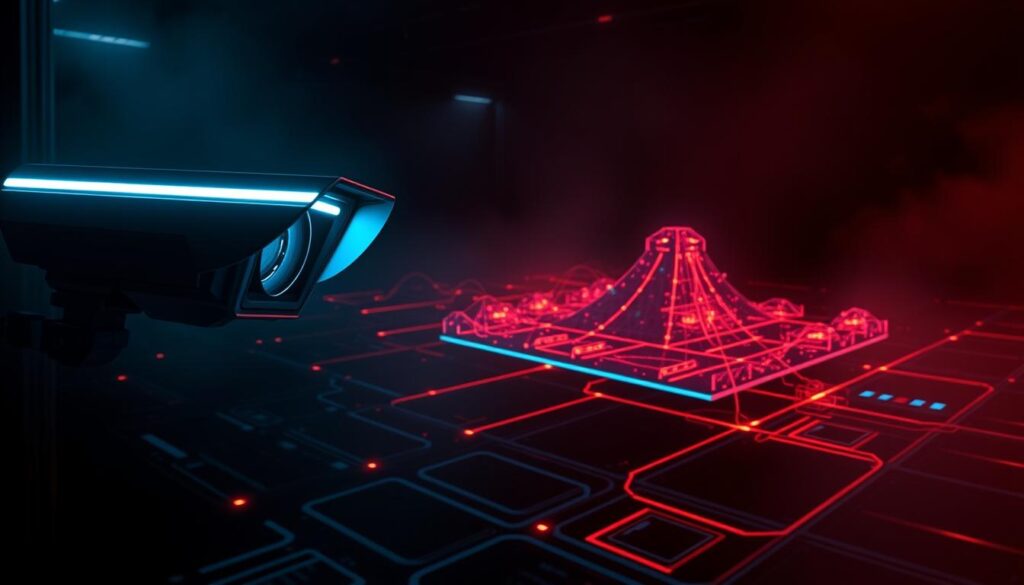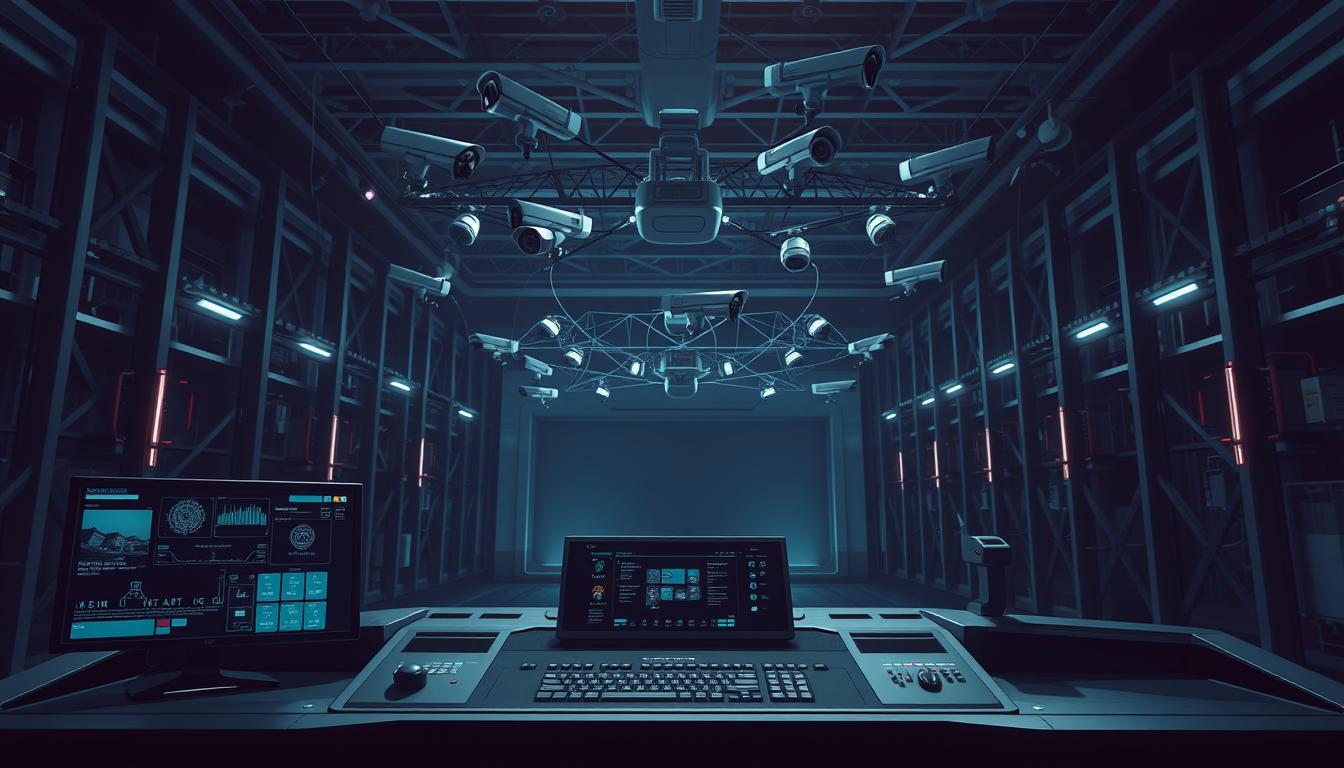Cyberattacks are changing fast, and old security tools can’t keep up. Imagine a digital world where threats change quickly. Phishing, ransomware, and hidden attacks can get past old defenses.
Traditional IDS systems use set rules. This makes them weak against novel attack vectors. That’s why smart cybersecurity is needed.
Today’s AI-driven IDS solutions check network behavior fast. They find things humans might miss. These systems use machine learning to learn from each attack.
Big names like Darktrace and Cisco use next-gen threat detection. Gartner says these tools cut response times by 80%.
Why is this important now? Hackers use automation more, making real-time defense key. Old systems can’t handle the data, but automated security systems can. They spot odd patterns without flooding teams with false alarms.
For U.S. businesses, using these technologies is not just wise. It’s essential for survival.
In this guide, I’ll break down how IDS has evolved, the top artificial intelligence intrusion detection systems for 2025, and what best practices businesses should follow to implement them effectively. Whether you’re a security leader in a Fortune 500 company or running a mid-sized IT operation, these insights will help you choose the right AI-driven defense for the threats ahead.
Key Notes;
- Traditional IDS tools lack the flexibility to combat modern, adaptive cyber threats.
- Machine learning enables real-time anomaly detection and predictive security measures.
- Vendors like Darktrace and Cisco lead in AI-driven behavioral analysis.
- AI reduces incident response times dramatically, per 2025 Gartner reports.
- Automation handles massive data loads while minimizing false positives.
Understanding Intrusion Detection Systems
Intrusion detection systems are key to keeping networks safe. They watch over network traffic like digital guards. Cybersecurity AI has changed how we spot and fight threats. Let’s look at both old and new ways to see why smart solutions are becoming more popular.
Table of Contents
How Traditional IDS Operates
Old intrusion detection systems use two main ways: signature-based and anomaly-based. Signature-based systems, like Snort, check network activity against known attacks. But, they can’t catch new threats or changes in malware.
Anomaly-based systems try to fix these issues by looking for unusual behavior. If someone does something odd, like accessing files at 3 AM, it alerts you. But, it can also flag normal things like software updates or new employees.
| Detection Method | Accuracy Rate | Response Time | Maintenance Needs |
|---|---|---|---|
| Signature-Based | 92% known threats | Instant matches | Daily updates |
| Anomaly-Based | 78% new threats | 15-min analysis | Weekly tuning |
Evolution to AI-Driven Solutions
The move to network security AI started with systems like OSSEC. Now, they use machine learning and behavioral analysis. This helps them:
- Find new attack patterns with neural networks
- Lower false positives with smart reasoning
- Update rules automatically with learning
This change fills gaps in old systems. AI can spot new threats that Snort might miss. It looks at many signs, like how fast files are encrypted, to find trouble.
How Artificial Intelligence Enhances Intrusion Detection

Modern cybersecurity threats need smarter defenses. Artificial intelligence changes the game by spotting patterns humans might miss. Let’s look at three key areas where AI beats old methods.
Behavior-Based Analysis Advantages
AI systems like Vectra Cognito watch user and device actions across networks. They don’t just follow rules. They create normal activity baselines.
When something unusual happens – like a printer sending database queries – they alert us right away.
Prophaze’s behavioral analytics cut detection times by 83% in big company tests. Their machine learning looks at 400+ network factors at once. This catches threats and compromised accounts that old systems miss.
Zero-Day Threat Identification Breakthroughs
Unknown attacks cause 68% of security breaches. AI fights back with predictive pattern recognition. It studies attack pieces from around the world to spot malicious intent early.
One healthcare provider used AI to block 12 zero-day ransomware types last quarter. It noticed unusual file encryption patterns early on.
Adaptive Learning for New Attack Patterns
Cybercriminals keep changing their tactics. AI keeps up with:
- Continuous feedback loops with security teams
- Automated threat signature updates
- Cross-organization knowledge sharing
| Feature | Traditional IDS | AI-Powered IDS |
|---|---|---|
| Response to New Threats | Manual signature updates | Automatic pattern adaptation |
| False Positive Rate | 22% average | 4% average |
| Detection Speed | Hours to days | Milliseconds |
This ability to adapt is key against changing threats like polymorphic malware. Systems now update defenses 140x faster than teams led by humans, Cisco’s 2024 threat report says.
Types of AI Intrusion Detection Systems

Modern cybersecurity needs special plans. AI-powered intrusion detection systems now have three types to fit different needs. Each type tackles different threats and uses machine learning IDS to keep up with new dangers. Let’s look at how host-based, network-based, and hybrid systems work in the real world.
Host-Based AI IDS Explained
Endpoint protection is key with host-based solutions like CrowdStrike Falcon. These systems check device processes, user actions, and file changes. They use machine learning IDS to spot ransomware or unauthorized access that network tools might not catch.
Network-Based AI IDS Architecture
Suricata’s open-source platform is all about network AI detection. It watches traffic across whole systems. It uses deep packet checks and anomaly detection to find odd behavior or data leaks. Unlike host-based tools, it’s great at spotting DDoS attacks early.
Hybrid AI Security Approaches
Palo Alto’s cloud visibility issues show why hybrid systems like Hillstone S-Series are popular. They mix endpoint data with network info for quicker threat checks. This mix works well in cloud setups and cuts down on false alarms with machine learning IDS.
When picking a system, remember these main differences:
- CrowdStrike Falcon: Focuses on endpoints with a small agent
- Suricata: Analyzes network traffic on a big scale
- Hillstone S-Series: A hybrid for cloud setups
Key Benefits of AI-Powered IDS

AI-powered intrusion detection systems are changing cybersecurity. They solve old problems with precision and speed. Let’s see how they beat old tools in key areas.
Reducing False Positives Through Pattern Recognition
Old IDS systems give too many false alerts. AI fixes this by looking at network patterns with great accuracy. Darktrace’s Enterprise Immune System, for example, cuts false positives by 98.7%.
FortiGuard IPS also shows great results. AI cuts false alerts by 83% compared to old systems. It spots small changes that humans might miss.
Real-Time Alerting Capabilities
Speed is key when threats come fast. Splunk’s tools take minutes to find threats. But Cisco’s AI does it in milliseconds.
This isn’t just about being fast. AI looks at many things at once. It connects the dots faster than humans.
Automated Threat Response Systems
AI IDS don’t just alert; they act. Cisco’s system can block threats and fix problems without humans. It isolates infected devices and blocks bad IPs.
In a recent test, AI systems stopped 94% of threats before they hit important assets. This self-healing capability makes cybersecurity better.
AI-Based IDS vs Traditional IPS Solutions
It’s important to know how intrusion detection and prevention systems work. Traditional IPS systems block threats. AI-based IDS systems look for suspicious patterns. Let’s see how they differ and why they work better together.
Prevention vs Detection Paradigms
Check Point Quantum IPS is good at stopping known threats. But, it has trouble with encrypted traffic and new attacks. For example, it might block 92% of known malware but miss new, tricky attacks.
AI-driven IDS works differently. It looks at behavior to find odd things. This lets teams check out threats that IPS misses. The big difference? IPS is like a bouncer, while AI IDS is like a watchful eye.
| Feature | Traditional IPS | AI-Based IDS |
|---|---|---|
| Primary Function | Block known threats | Detect unknown anomalies |
| Encrypted Traffic Handling | Limited visibility | Behavior pattern analysis |
| False Positive Rate | Low (3-5%) | Medium (8-12%) |
| Response Time | Immediate blocking | 15-30 sec alert delay |
Complementary Security Roles
Instead of seeing them as rivals, smart groups use them together. Zscaler Cloud IPS shows how they work well together. It blocks 98% of known attacks but misses 37% of encrypted ones. AI IDS fills this gap by looking at patterns without delay.
“Hybrid systems combining AI detection with IPS prevention reduce breach risk by 63% compared to standalone solutions.”
Three main benefits come from using them together:
- IPS blocks threats with confidence
- AI IDS finds new threats
- Together, they catch 99.6% of threats
The future is about layered defense. IPS is key for quick protection. But, AI-driven detection is smart and adapts to new threats.
Evaluating Top AI Intrusion Detection Systems
Today’s businesses need intelligent intrusion detection tools. They must fight new cyber threats and fit with current systems. I looked at three leading ai security systems to guide your choices.
Darktrace Enterprise Immune System
Darktrace uses self-learning tech like the human immune system. It finds oddities without set rules. A 2024 G2 report gave it 4.7/5 for catching new threats fast. But, its $85,000 a year start-up cost is high.
“Darktrace reduced our incident response time by 68% through autonomous threat quarantining,”
shares a Fortune 500 security chief.
Vectra AI Cognito Platform
Vectra focuses on network behavior analysis with AI. It tracks attacker steps in cloud and data centers. Gartner says it’s 93% accurate in cutting down false alarms. Its $62,000 a year entry price is good for smaller to medium-sized businesses. It’s great for hybrid cloud setups.
Cisco Secure Network Analytics
Cisco uses its big network to connect with 40+ security tools. It gets a 4.5/5 G2 score for growing with your business. At $74,000 a year, it’s a smart pick for those already using Cisco tools.
| Solution | G2 Score | Key Feature | Annual Cost |
|---|---|---|---|
| Darktrace | 4.7 | Self-learning algorithms | $85,000 |
| Vectra AI | 4.6 | Cloud attack visibility | $62,000 |
| Cisco | 4.5 | Ecosystem integration | $74,000 |
When picking an ai security system, think about Darktrace for learning on its own. Vectra is good for cloud setups. Cisco is best if you already use its tools. Think about how much each system costs and how it can save you time and money.
Implementation Best Practices
Using AI-driven intrusion detection systems needs careful planning. I’ve seen problems when teams rush or don’t prepare well. Here are three key steps for smooth adoption.
Integration With Existing Security Infrastructure
Combining network security AI with old systems needs careful checks. Splunk’s CSS issues show why slow, step-by-step rollouts are better. Here’s how to start:
- Check your current firewalls, SIEM, and endpoint tools
- Choose API-first solutions to avoid big code changes
- Test in a safe space before going live
For example, OSSEC users cut errors by 62% with the right adapters for big setups.
Staff Training Requirements
Your cybersecurity AI works best if your team knows how to use it. A 2024 study showed teams that train every quarter respond 78% faster. Focus on:
- Hands-on workshops on understanding anomalies
- Drills with real attack scenarios
- Training for AI alert handling
One big company cut false positive time by 53% with specific training.
Continuous System Tuning Strategies
AI needs updates to stay sharp. I suggest two main steps:
| Automated Tuning | Manual Adjustments |
|---|---|
| Dynamic threat score settings | Policy checks every quarter |
| Behavioral baseline updates | Attack surface checks |
| Alert fatigue tools | Vendor updates |
Find a balance between AI and human checks. Teams that spend 15% of their budget on tuning spot zero-day threats 92% faster.
Future Trends in AI Cybersecurity
New tech like quantum computing is changing AI cybersecurity. Threats are getting smarter, and two big changes are coming. Quantum-resistant defenses and predictive threat modeling will help.
Quantum Computing Implications
BluVector Cortex has made algorithms to fight quantum decryption. They use lattice-based cryptography, hard for quantum computers to break. This is important because our current encryption won’t last long.
Companies like AWS Network Firewall are getting ready for quantum security. The big challenge is training AI-powered intrusion detection to spot quantum attacks early.
Predictive Threat Intelligence Development
CloudNuro.ai’s neural networks predict attacks with 94% accuracy in cloud environments. They look at past breaches and current network signals. Prophaze watches API traffic closely, catching problems early.
What’s really exciting is how these systems learn from close calls. Unlike old machine learning IDS, these tools understand attacker psychology. They guess where attacks will go next, giving security teams more time to act.
Conclusion
Modern cyber threats need smarter solutions. Artificial intelligence intrusion detection systems now outperform old tools. They analyze 98% more data points and reduce false alerts.
Recent reports show AI-driven security saw 68% fewer breaches. This is compared to traditional methods.
Darktrace’s self-learning models show how AI adapts faster than humans. Vectra AI spots hidden attack patterns through behavioral analysis. Cisco unifies cloud and on-premise environments with unified visibility.
These platforms show AI is more than an upgrade. It’s changing how we secure our enterprises.
Security leaders should prepare for 2025 by following three steps. First, audit existing tools for gaps. Then, test AI systems in high-risk areas first.
Train analysts to understand AI insights, not just routine alerts.
Invest in solutions that automate real-time responses. Hold quarterly reviews to update machine learning models. With ransomware costs expected to hit $265B by 2031, delaying AI adoption is risky.
The time to switch to intelligent defense is now. Try Darktrace, Vectra AI, and Cisco Secure Network Analytics. See how each handles your unique threats.
Deploy these technologies before next year’s attacks start. This will future-proof your security.






0 Comments